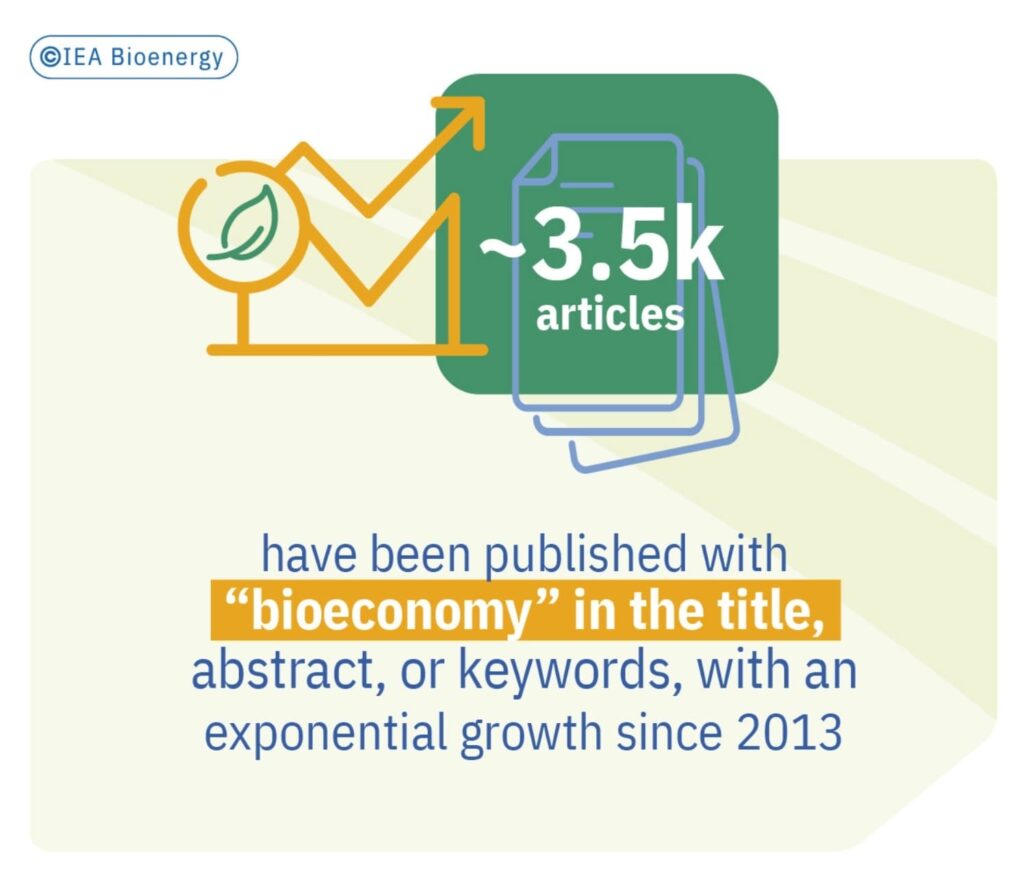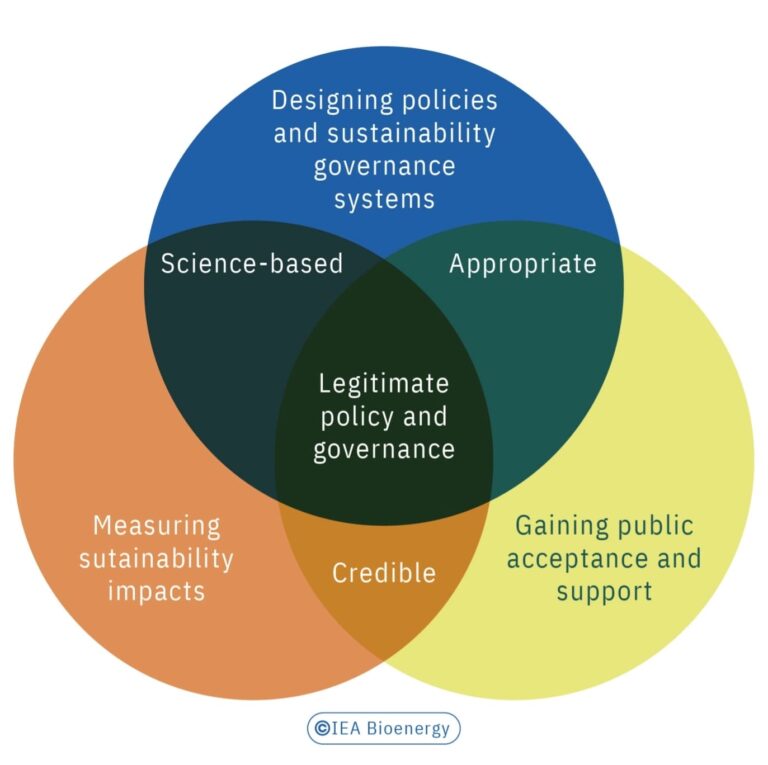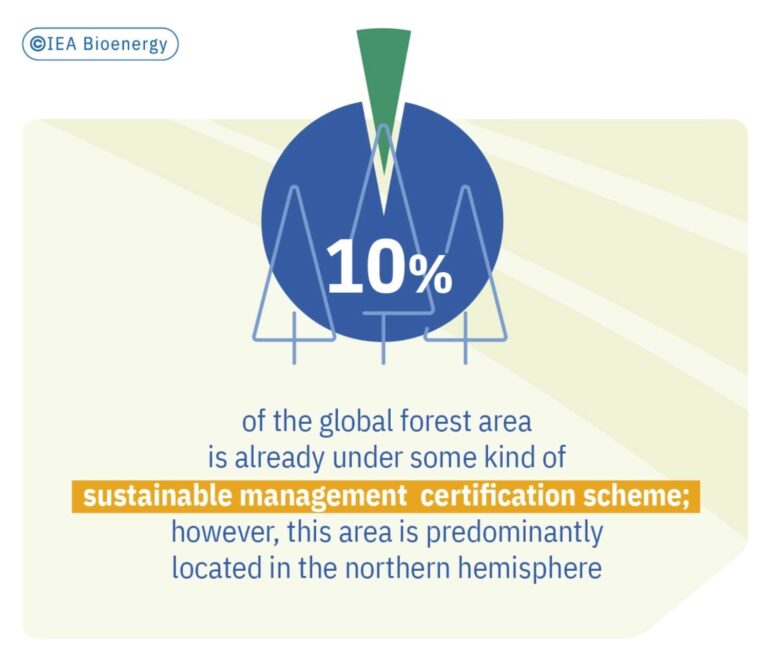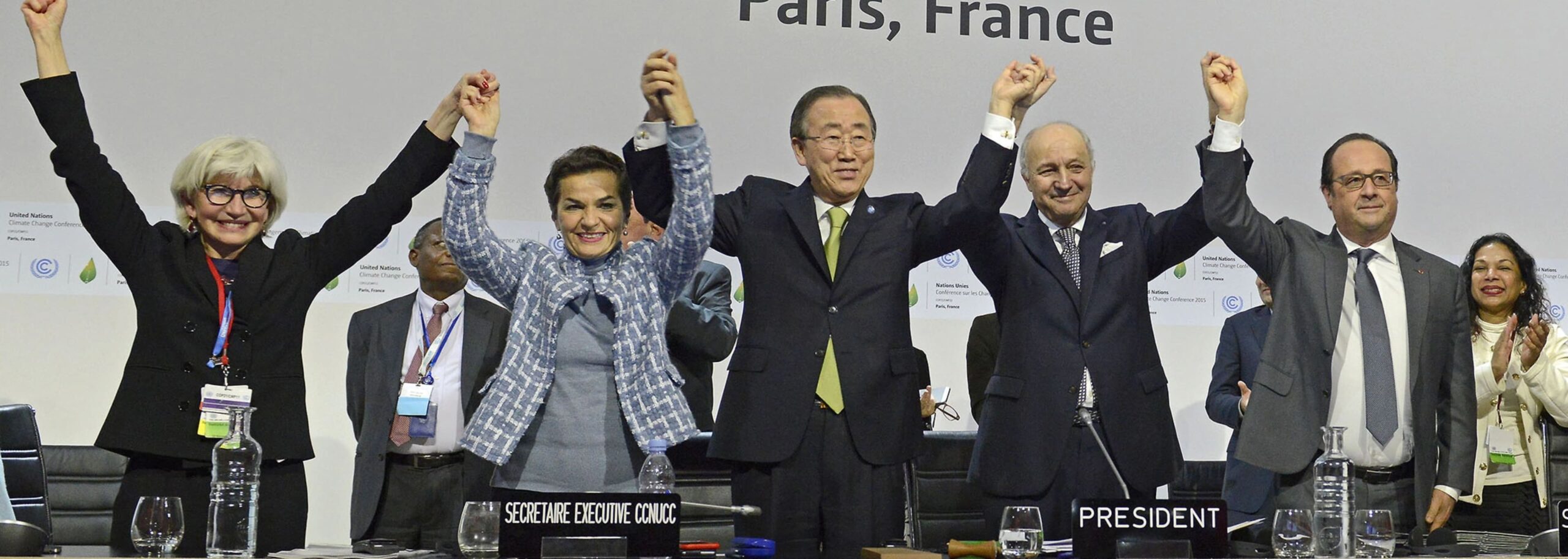Towards a circular bioeconomy and other sustainability avenues
While countries, citizens, and scientists have committed to the Paris Agreement, sustainable bioenergy is frequently dismissed as being too complex or even unachievable; arguments often emphasise the perceived competition between energy, material, and nutrient services. It is true that bioenergy systems are highly interconnected, develop dynamically, and have different impacts at different scales. It is exactly this complexity, however, that holds significant opportunities for entering different sustainability avenues and making the successful transition to a carbon- neutral economy.

Strategies for a transition towards a sustainable circular bioeconomy
Today, many countries of the Organisation for Economic Co-operation and Development (OECD) have dedicated bioeconomy strategies in place. Although respective strategy documents vary strongly with regard to the type of bioeconomy policy development, and the extent of information on it, we can highlight a common denominator: the sustainable integration of agriculture, forestry, aquaculture, and their primary, secondary, and tertiary residues into an economy in transition.

At the same time, circularity is high on the agenda for some OECD world regions. Circularity is tantamount to resource efficiency through, for example, reduction, repair, remanufacturing, recycling, and repurposing of products. With modern bioenergy strategies focusing on residues, and the interweaving of material, nutrient, and energy services, bioeconomy concepts and bio- based economic activities have to be understood not only as part of the circular economy, but also as its pioneer sectors (IEA Bioenergy Task 42 perspectives document and the CBE JU proposal annex).
To build upon these circular economy and bioeconomy efforts and to harness the opportunities of the circular bioeconomy, the prevailing circular policy centre of attention on the end-of-life (EoL) of selected product types (see Milios, 2018) has to be extended to a more holistic supply chain view, including sourcing (including waste/secondary feedstock markets), manufacturing, and especially bio-based products and processes. By shifting the current emphasis from competition between bioenergy and other bio-based sectors to their manifold synergy opportunities, significant contributions can be expected for both the circular and the bioeconomy strategies.

Sustainability governance bridging all sectors
The joint consideration of the different circular bioeconomy sectors in particular, holds the potential to transfer sustainability governance for bioenergy to other bioeconomy sectors. Processes and supply chains providing bio-based products, food, and feed services could be improved if environmental standards from bioenergy supply chains were to be transferred. Innovative concepts and policy measures such as monitoring indirect land-use change or the large-scale implementation of sustainable forest and landscape management could have an impact on sustainable agriculture and forestry for all bio-based services.

High shares of variable renewable energy will also require biogenic carbon and energy, for example for synthetic fuels and system flexibilisation/stabilisation. Furthermore, the integration of biogenic carbon supply chains into the renewables-based economy sectors provides the opportunity to significantly diversify the stakeholders and shareholders participating in the overall value creation and thus contribute to resource democratisation. Frameworks and market instruments to valorise social sustainability, for example by rewarding smaller producers and stakeholder diversity, have to be developed and implemented.
The way forward: policy, legislative, and technological frameworks needed
Knowledge and know-how on the bioenergy and biomass markets will be decisive for future biogenic carbon carrier markets for a circular bioeconomy. The sustainable and decentralised character of the integration of the primary economic sectors can provide societal benefits. Environmental and economic sustainability can be improved through resource efficiency and synergies between various energy, material, and food and feed services. The further interweaving of separated supply chains into biogenic carbon supply networks, however, especially regarding a circular bioeconomy, comes with some challenges:
- Biomass provides more than energy and carbon. A departure from the currently prevailing reductionist approach is necessary to valorise the different, more complex bio-based components of biomass—without breaking down macromolecules into smaller building blocks; such useful macromolecules include proteins, sugars, oils and fats, fibres, cellulose, and hemi- cellulose.
- The technical, economic and environmental evaluation of more than one main product, for example a product portfolio in a biorefinery, is not straightforward. A thorough and standardised characterisation of the bio-based processes can help and should be extended to entire supply networks.
- Standardisation, certification, and labelling of bio-based products and of biogenic carbon carriers must consider an impressively broad range of product performance indicators (see StarProBio project) while tackling a highly diverse and varying feedstock base.
- Economies of scale render the current economy cost-effective but also rather centralised. Small- scale biorefineries, regional supply chains, and biorefinery or circular bioeconomy communities provide significantly more societal and SDG-related benefits. Thus, downscaling will have to be supported by research and development and market instruments for the deployment of the smallest functional units.
To be able to reveal the added value of the bio-based sectors, including bioenergy for the economy and our society, we need to acknowledge their opportunities and challenges. The circular bioeconomy will be based on the potentially last remaining primary economic sectors, forestry, agriculture, aquaculture, and secondary feedstocks via cascading use. By aiming for environmental, economic, and social sustainability in these primary economic sectors we could significantly contribute to a transformation towards a fair and just society under stable environmental conditions.
- IEA Bioenergy Task 42 (2018) Bioeconomy and biorefining strategies in the EU Member States and beyond LINK accessed 18/02/2022
- Annevelink B (2018) The IEA Bioenergy Task 42 Perspective for Biorefining in a Growing Bioeconomy LINK accessed 18/02/2022
- European Commission (2020) Draft proposal for a European Partnership under Horizon Europe European Partnership for a Circular bio-based Europe: sustainable innovation for new local value from biowaste and biomass (CBE) LINK accessed 18/02/2022
- Stockholm Environment Institute (SEI) (2020) LINK accessed 22/06/2022
- Milios (2018) Advancing to a Circular Economy: three essential ingredients for a comprehensive policy mix, Sustainability Science 13, 861–878 LINK
- Schipfer F, Pfeiffer A et al. (2022 Strategies for the Mobilization and Deployment of Local Low-Value, Heterogeneous Biomass Resources for a Circular Bioeconomy Energies 15(2), 433; LINK
- IEA Bioenergy Task 40 (2019) Projects 2019-2021 LINK accessed 22/06/2022
- IEA Bioenergy Task 42 Report (2020) Bio- Based Chemicals – A 2020 Update LINK accessed 18/02/2022
- IEA Bioenergy Task 42 (2016) Proteins for Food, Feed and Biobased Applications: Biorefining of protein containing biomass LINK accessed 18/02/2022
- IEA Bioenergy Task 42 (2018) Natural Fibers and Fiber-based Materials in Biorefineries Status Report 2018 LINK accessed 18/02/2022
- IEA Bioenergy Task 42 (2019) Technical, Economic and Environmental Assessment of Biorefinery Concepts: Developing a practical approach for characterization LINK accessed 18/02/2022
- IEA Bioenergy Task 42 Report (2018) Standards and Labels related to Biobased Products LINK accessed 18/02/2022
- Star ProBio Project Sustainability Transition Assessment and Research of Bio-based Products LINK accessed 18/02/2022
- IEA Bioenergy Task 42 (2017) Wageningen University & Research Report: Small-scale biorefining LINK accessed 18/02/2022
- Schipfer F, Pfeiffer A et al. (2022) Strategies for the Mobilization and Deployment of Local Low-Value, Heterogeneous Biomass Resources for a Circular Bioeconomy. Energies 15 (2), 433. LINK
6 Enabling policies and research needs
Bioenergy Deployment, markets, and trade
Sustainable bioenergy depends on the continuous supply of biomass, including residues from agriculture, forestry, or industry processing, post-consumer waste, perennial crops, cover crops, and other plantings. Designing markets and supply chains for these highly heterogenous and dispersed goods is particularly challenging but holds great opportunities for the primary, upstream, and circular economic sectors
Be it for heating the home or lighting the office, bioenergy services rely on a continuous supply of biomass feedstock. Bioenergy carrier and biomass markets need to be created with the support of appropriate policies, providing benefits to the multiple stakeholders and shareholders along the supply chain. On the one hand, this renders bioenergy deployment a rather complex endeavour. On the other, it provides a unique richness of opportunities in the primary, upstream, and circular economic sectors.

On the inherent challenges of creating markets for freshly sourced biomass
Supply of biomass for bioenergy applications is naturally organised in a much more decentralised manner than, for example, crude oil sourcing. Unlike oilfields or coalmines, forests and farms are geographically highly dispersed and supply chains involve a variety of stakeholders and shareholders and several supply chain steps.
Within the IEA Bioenergy TCP, the experts of IEA Bioenergy Task 40 are devoted to overcoming the barriers and revealing the opportunities of biomass supply chains with a market perspective, while the IEA Bioenergy Task 43 community focuses on sustainable production and supply and IEA Bioenergy Task 45 on sustainability governance. As biomass supply for energy, material, and food and feed services are inherently linked, recommendations for policy, stakeholders, and shareholders often have a multi-sectoral character. This section thus focuses on providing guidelines for market creation. Residues from forestry, agriculture, or bio-based industries such as sawmills, paper production, food processing, or waste water treatment have some particularly unsatisfactory properties in terms of longer-distance transportation and storage. How can these types of resource be mobilised to meet demand for energy services when those services are located somewhere else or are required days or even months later?

Improving biomass properties for transportation and trade
Biomass pre-treatment can be used to improve properties such as the carbon and energy content and stability of freshly sourced biomass. Through pre-treatment such as chipping, pelletisation, torrefaction, or pyrolysis, longer-distance transportation becomes economically feasible, while homogenisation enables trade because traders and final consumers can better rely on the quality of their purchase. Tradability, also for longer distances over country borders, as well as for inter-modal handling and storing over seasons, is thus understood as a prerequisite for creating markets for bioenergy carriers.
With mobile or small-scale pre-treatment still being rather a niche application today (T40 RT report), most pre-treatment businesses want to harness economies of scale by maximising their capacities. Scaling has to be economically traded-off against feedstock or residues yield, cost, availability, and accessibility which may considerably vary over time and also depend on competing demand developments. Thorough evaluations of these factors are recommended before setting up pre-treatment plants. GIS-based approaches, seasonal scheduling, and feedstock flexibilisation will help this sector progress in the near-term future.
Commoditisation, international trade, and deployment
While pre-treatment of biomass residues is a prerequisite for bioenergy carrier markets, it is often not enough: commoditisation and international trade have thus been on the main agenda, especially of IEA Bioenergy Task 40. Commoditisation means the creation of an interchangeable and standardised or certified good which is traded on a transparent and efficient physical market allowing for equilibrating price dynamics. The challenge now lies in defending and supporting stakeholder and shareholder diversity, an overlooked unique selling proposition of bioenergy supply chains (T40 RT project); this will occur through local mobilisation while interweaving local supply chains into efficient international markets.

Several bioenergy carriers have been discussed as possibly established commodities: markets for wood chips, biomethane, liquid biofuels, and wood pellets have been closely examined in recent years. Wood pellet markets have received special attention, mainly because of their importance in European renewable heat and power supply, their significant trade flows, and their basis of relatively good data. High search costs for comparable price information, the lack of sustainability labelling and of acceptance for internationally traded pellets do, however, limit the commoditisation and market creation process of this major bioenergy carrier.
Creating biogenic carbon markets of tomorrow
We nevertheless consider wood pellets as a promising future and leading bioenergy carrier commodity, not only for extending the application of bioenergy for power and high-temperature industrial heat but also for providing carbon for steel production or for negative emissions in BECCS facilities. Further technical advances with regard to densification but also progress in terms of sustainable governance and harnessing the socio-economic benefits of pellet supply chains will thus play an important future role.
Finally, the feedstock basis upon which the portfolio of intermediary biogenic carbon carriers is currently built has to be extended, as today only small shares of biomass feedstocks are being utilised. Short-rotation coppice such as eucalyptus, switchgrass or willow, different types of agricultural residues and also grasslands or and aquaculture, (e.g., harvested algae from high-eutrophication water bodies) exhibit untapped sustainable potentials.
A combination of mobilisation strategies will help to improve not only the environmental but also socio-economic performance of sustainable bioenergy markets. GIS-based and data-intensive harvesting and mobile densification services can mobilise distributed resources that are of fluctuating or sudden occurrence. Physical Bio-Hubs act as collection centres, and distribution platforms to provide the biomass for bioenergy and other bio-based applications of tomorrow.
Environmental and social sustainability standardisation and commoditisation ensure the highest societal benefits in the primary economic sectors, while facilitating market uptake of biomass commodities. Multi-level governance ensures cohesion among policy goals at the international, national, and regional level and involves bioeconomy communities so that markets can evolve to
benefit all participants.
- IEA Bioenergy Task 42 (2012) The potential role of biofuels in commercial air transport – biojetfuel LINK accessed 18/02/2022
- Iriarte L, Fritsche UR (2021) Sustainability governance of bioenergy and the broader bioeconomy LINK accessed 22/06/2022
- IEA Bioenergy (2019) Biomass pre- treatment for bioenergy – Policy report LINK accessed 18/02/2022
- IEA Bioenergy Task 40 (2015) Possible effects of torrefaction on biomass trade LINK accessed 22/06/2022
- Schipfer F (2017) Densification and conversion technologies for bioenergy and advanced biobased material supply chains – a European case study. Dissertation, Technical University of Vienna LINK
- Schipfer F, Kranzl L (2019) Techno- economic evaluation of biomass-to-end- use chains based on densified bioenergy carriers (dBECs) Applied Energy 239, 715-724 LINK
- IEA Bioenergy (2016) Developing the Global Bioeconomy Technical, Market, and Environmental Lessons from Bioenergy LINK accessed 18/02/2022
- IEA Bioenergy Task 40 Report (2013) Future perspectives of international bioenergy trade LINK
- IEA Bioenergy Task 40 (2012) Global wood chip trade for energy LINK accessed 18/02/2022
- IEA Bioenergy Task 40 and Task 37 (2014) Biomethane Status and Factors Affecting Market Development and Trade LINK accessed 18/02/2022
- IEA Bioenergy Task 40 (2017) Global Wood Pellet Industry and Trade Study 2017 LINK accessed 18/02/2022
- Schipfer F, Kranzl L et al. (2020) The European wood pellets for heating market – Price developments, trade and market efficiency Energy 212,118636 LINK
- IEA Bioenergy Task 40 (2019) Margin potential for a long-term sustainable wood pellet supply chain LINK accessed 18/02/2022
- IEA Bioenergy Task 40 (2019) Socio- economic assessment of the pellets supply chain in the USA LINK accessed 18/02/2022
- IEA Bioenergy Task 43 (2018) Suitable Land Slots for SRC plantations Multi Criteria Decision Analysis LINK accessed 18/02/2022
- IEA Bioenergy Task 43 (2011) Short Rotation Eucalypt Plantations for Energy in Brazil LINK accessed 18/02/2022
- IEA Bioenergy Task 43 (2011) Switchgrass Production in the USA LINK accessed 18/02/2022
- IEA Bioenergy Task 43 (2013) Short Rotation Coppice with willow in New Zealand LINK accessed 18/02/2022
- IEA Bioenergy Task 43 (2017) Mobilization of Agricultural Residues for Bioenergy and Higher Value Bio-Products: Resources, Barriers and Sustainability LINK accessed 18/02/2022
- Hansson J, Berndes G et al. (2019) Bioenergy and grasslands – Different approaches to addressing biodiversity and their influence on biomass supply potentials. Global Change Biology Bioenergy, 11, 517-538.y LINK
- IEA Bioenergy Task 40 (2018) Transboundary flows of woody biomass waste streams in Europe LINK accessed 18/02/2022
- IEA Bioenergy Task 43 LINK accessed 22/06/2022
FURTHER READING
- Heeley B, Ghaffariyan M et al. (2019) International assessment of bioenergy stakeholders research requirements of GIS based biomass analytics Journal of Forest Science, 65: 234-246 LINK
- Junginger M, Chun Sheng Goh C et al. (2014) International Bioenergy Trade History, status & outlook on securing sustainable bioenergy supply, demand and markets LINK
- Tattersall Smith C, Lattimore B, et al. (2017) Opportunities to encourage mobilization of sustainable bioenergy supply chains WIREs Energy and Environment, 6:e237. LINK
6 Enabling policies and research needs
Governance that safeguards environmentally and socially sustainable biomass sourcing and bioenergy production
Securing a sustainable supply of biomass is at the heart of the deployment of bio-based value chains, including bioenergy and biomass-based products
Environmentally and socially sound production of biomass is a key strategy to ensure sustainable cross-sectoral bio-based supply chains, while being pivotal for any bioeconomy system. A number of steps need to be taken to establish good governance systems, and it is also important to raise awareness among citizens and build trust.

A crucial factor here is to build up and create trust among the public and consumers that biomass can be sustainable at all; and, furthermore, that it can be produced sustainably everywhere in the world and not only in some temperate forests in the northern hemisphere. This requires credible and transparent governance systems based on monitoring and traceability.

Sustainable wood production and its benefits need higher visibility
Little attention is given to sustainable production and consumption of wood products on the international development agenda. This is despite sustainable use of natural resources, including forests, being a key principle of the 2030 Agenda for Sustainable Development and the 2015 Paris Agreement and the important contribution of forests to climate change mitigation and adaptation being highlighted.
A major reason is persistent reporting on instances of unsustainable practices (e.g., in forestry, and also in oil palm plantations, etc.) by media from practically all over the world. Such reporting has contributed to a lack of finance for building sustainable wood value chains and has hampered marketing efforts. The FAO and Collaborative Partnership on Forests (CPF)-led “Sustainable Wood for a Sustainable World (SW4SW)” initiative has also identified these obstacles; it has been concluded that it is vital to increase the visibility of the benefits of sustainable wood (biomass/bio-based feedstocks) production and consumption: mindsets must be shifted to encourage a more positive and responsive attitude so that sustainable wood value chains can be developed and strengthened. SW4SW highlights the fact that joint efforts are essential to improve understanding of i) what sustainable wood value chains entail; ii) where they can be found, created, or strengthened; iii) what business models are associated with them; and iv) how they can better contribute to achieving development goals at different levels.
Increasing the legitimacy of sustainability governance for bioenergy and the bioeconomy
Increasing international trade of bioenergy products has stimulated interest in the need for broader bioenergy sustainability criteria. Moreover, IEA Bioenergy in a collaborative activity with its global research networks, including the Nordic Council of Ministers, has addressed this pivotal sustainability governance question through a series of studies, publications, and workshops.
A study found that a high level of legitimacy is a precondition for building trust that the system will lead to acceptable and beneficial outcomes (based also on strict validation and monitoring of e.g., achievement of sustainability criteria). Central to this discussion is the nexus of science, policy, and governance, and public acceptance:
There is evidence that people are more likely to perceive a governance system as being legitimate when its design is underpinned by rigorous science, when the science is seen as credible, and when the exertion of power of the governance system is seen to be fair and appropriate. A critical element is always effective monitoring and validation as well as transparent communication of results to ensure that the desired outcomes are being achieved and that the public is aware of this.

Another study discusses the controversy surrounding bioenergy, namely that bioenergy is assumed to be playing a key role in the transition to a sustainable economy in Europe, but that its own sustainability is being questioned in some cases and application types, particularly the use of biomass in large-scale power plants.
Examples from the Nordic countries (Denmark, Finland, Norway, and Sweden) show that many common sustainability risks (including e.g., deforestation, degradation, resource competition, and lack of acceptance) can be managed in the region based purely on voluntary measures. Obviously, risks to economic sustainability may be more challenging than ecological risks, given that, for instance, the competitiveness order of renewable energy technologies (i.e., the relative ranking of photovoltaic, wind and bioenergy) has been reversed in the last decade.
The risk of resource competition harming other sectors in the economy was found to be small and manageable but needing continuous monitoring. Local bioenergy communities turned out to be strong agents of change behind the most expansive bioenergy chains. For these local communities, the fear of non-local actors reaping the economic gains involved in bioenergy chains was found to be one of the larger risks to the trust and acceptance necessary to act as bioenergy communities. From the Nordic experience, it has been concluded that further to the institutional framework involving laws, regulations, and standards, community commitments are essential, and a strong stakeholder involvement is key in sustainable bioenergy development and use—both to safeguard the legitimacy of bioenergy development and to reconcile tensions between the global quest for a climate neutral economy and the local quest for an economically viable community.

Further to this discourse, scientists state that public acceptance is crucial for promoting sustainable bioenergy and that, consequently, increased acceptance would lead to a greater potential for growth in market share. Public acceptance, in turn, is mainly based on gaining public trust and attracting public support, which requires an efficient policy framework and interactive communication among bioenergy stakeholders.
In parallel to increasing demand for wood pellets in EU member states, the demand for establishing sustainability risk control for the transatlantic trade in wood pellets between the USA and Europe has grown. In addition to EU-wide sustainability requirements for renewable energy, various national regulations need to be met by the importing countries.
With the USA supplying 27% of the EU’s pellet demand, sustainability certifications used by the forest bioenergy industry are identified as a key compliance tool regarding EU and member state sustainability criteria, with special emphasis needing to be placed on the feedstock-sourcing procedures and strategies in actual supply chains. This study finds that larger pellet mills usually use less feedstock sourced from certified forest management operations, while medium-sized mills source more certified feedstock. For larger mills, therefore, the greatest challenge seems to be the time-consuming and often technically complex tracing of feedstock origin back to the
forest.
A joint report by IEA Bioenergy Task 45 and GBEP concludes that although the importance of bioenergy and bioeconomy governance is increasingly recognised and implemented at different levels, a comprehensive and cross-sectoral and transboundary coordination is still lacking. The nature of connections between primary production (agriculture, forestry, etc.) and conversion (chemicals, construction, energy, fibre, food etc.) requires their interactions to be considered across sectors and beyond national boundaries.
As national SDG frameworks are in the process of being adapted and implemented, there is an opportunity to create synergies between bioenergy and the SDGs. As of now, however, the governance of national SDG implementation is weak, and it may well be necessary to develop a specific bioeconomy governance or “umbrella” framework such as the European Green Deal to integrate sector policies vis-à-vis the bioeconomy.
Sustainability certification and monitoring
These figures come with a significant uncertainty, given the shaky background statistics on global wood production, qualities (e.g., for bioenergy uses), and the unclear situation with respect to overlapping certified forest area under different labels and schemes. They do, however, give an indication of the present order of magnitude of global sustainable biomass production from the forest sector. Nevertheless, while about 10% of the global forest area is already under some kind of sustainable management certification scheme, it has to be said that this area is predominantly
located in the northern hemisphere.

For the year 2021, the Sustainable Biomass Program (SBP), an organisation that aims to promote economically, environmentally, and socially sustainable biomass supply through certification, lists 339 SBP certificate holders across 33 countries (including e.g., Australia, Brazil, Canada, China, France, Germany, Japan, Malaysia, Norway, Russia, Spain, Sweden, the UK, and the USA). Together, under their respective schemes, these SBP certificate holders produced and sold on the market more than 13.4 million tons of wood pellets and 1.6 million tons of chips in 2020. These figures indicate that there is already a solid basis for bioenergy feedstock from sustainability- certified origin. However, the aim is to have no unlabelled or unsustainable biomass on the market.
Stakeholder opinion
An assessment of the global view of stakeholders in 2018 (including e.g., biomass producers/ users, the general public, academia, NGOs, and policymakers) found that the stakeholders are largely aware of bioenergy development and have a positive view of the sector; the general public is less aware of bioenergy development, however, and not sufficiently committed to it.
Internet and social media were found to be the most consulted sources of information but were also the least trusted, whereas scientific information was the most trusted, but least used. Agricultural residues, energy crops from marginal or degraded land, and forestry residues are widely accepted as feedstocks for bioenergy production. The use of primary feedstock (crop) produced on agricultural land or entire stemwood harvested from the forest, however, attracts criticism. Bioenergy development is generally supported when jointly agreed sustainability requirements are met.
Overall, stakeholders consider that sustainability requirements, including social, economic, and environmental aspects, should be mandatory if they are to fully support the bioenergy sector. They also attach an important role to scientific information. Other expected preconditions for enhanced bioenergy support and gaining greater social acceptance are transparency in demonstrating compliance with sustainability criteria and establishment of a level playing field for equitable market conditions.
A recent IEA Bioenergy workshop on “Governing sustainability in biomass supply chains for the bioeconomy” concluded that as well as creating trust through credible governance systems, monitoring, traceability, and transparency, an important further step will be to agree on and implement a minimum set of key sustainability criteria and related indicators (e.g., based on the GBEP sustainability indicators) in relation to the most important risks and opportunities needing to be addressed by sustainability governance.
Sustainability governance of bioenergy should not be separated from other uses of biomass and the broader bioeconomy. In future dialogues all bio-based value chains need to be represented, as do policymakers, the private and finance sectors, and sectors beyond the bioenergy and bioeconomy community—all with a special emphasis on the younger generations.
- IEA Bioenergy (2019) Governing sustainability in biomass supply chains for the bioeconomy – Summary and conclusions from the IEA Bioenergy workshop, Utrecht (Netherlands), 23 May LINK accessed 18/02/2022
- FAO United Nations Food and Agriculture Organization (2017) Sustainable Wood for a Sustainable World (SW4SW). Available at: LINK accessed 18/02/2022
- Stupak I, Tattersall Smith C et al. (2021) Governing sustainability of bioenergy, biomaterial and bioproduct supply chains from forest and agricultural landscapes. Energy, Sustainability and Society 11,12. LINK
- Hansen AC, Clarke N et al. (2021) Managing sustainability risks of bioenergy in four Nordic countries. Energy, Sustainability and Society 11,20. LINK
- Kittler B, Stupak I et al. (2020) Assessing the wood sourcing practices of the U.S. industrial wood pellet industry supplying European energy demand. Energy, Sustainability and Society 10:23. LINK
- Iriarte L, Fritsche UR (2021) Sustainability governance of bioenergy and the broader bioeconomy LINK accessed 18/02/2022
- Cowie A, Berndes G et al. (2021). Applying a science-based systems perspective to dispel misconceptions about climate effects of forest bioenergy. Global Change Biology-Bioenergy. 13,1210–1231 LINK
- UNECE United Nations Economic Commission for Europe. 2016: Chapter 2, Policies Shaping Forest Products Markets, In: UNECE/FAO Forest Products Annual Market Review, 2015-2016, Geneva Timber and Forest Study Paper 40, ECE/TIM/SP/40. United Nations, New York and Geneva 2016, United Nations Publications, ISBN 978-92-1-117115-0, pp.11-20. LINK accessed 18/02/2022
- Kraxner F, Schepaschenko D, et al. (2017). Mapping certified forests for sustainable management – A global tool for information improvement through participatory and collaborative mapping. Forest Policy and Economics 83,10-18 LINK
- SBP Sustainable Biomass Program (2021) Facts and Figures, LINK accessed 18/02/2022
- Mai-Moulin T, Fritsche UR, Junginger M (2019) Charting global position and vision of stakeholders towards sustainable bioenergy. Energy, Sustainability and Society 9:48. LINK
6 Enabling policies and research needs
Technology research, development, and deployment needs for a low-fossil-carbon energy system
As half of the technologies needed to fully decarbonise by 2050 are not yet commercially available, further research and development of bioenergy technologies is crucial
The analysis done by IEA for the Net Zero by 2050 roadmap found that about half the technologies that will be applied in our future low-fossil-carbon energy system have not yet been fully developed to commercial scale. Thus, research, development, and deployment activities (RD&D) constitute essential parts of climate change mitigation. While different biomass conversion technologies face quite specific challenges, overall RD&D needs can be identified along the value chain from biomass cultivation to end-use.

Basic research is a cornerstone to successful technology development for a low- fossil-carbon energy system (Photo credit: Pexels | Edward Jenner)
To fully deploy bioenergy technologies in our future low-fossil-carbon energy system, RD&D is needed along the value chain from biomass cultivation to end-use. In the IEA Bioenergy Roadmap, IEA energy analysts and IEA bioenergy experts list the numerous topics in several fields, as described below.
Biomass cultivation and supply should be improved through optimisation of crop yields and introduction of new varieties, through minimising inputs such as nutrients and water, and through sustainable biomass sourcing and the establishment of sustainable supply chains. Further R&D needs of biomass cultivation include development of low ground pressure harvesting machinery to extend the amounts of land suitable for bioenergy and to widen the harvesting window, and investment in robotic technologies to aid planting, maintenance, and harvesting in fields. Further work is also needed to understand biomass degradation in storage. Finally, beneficial ways of integrating biomass with conventional agriculture need to be further investigated, so as to take full advantage of possible soil quality improvements, to limit eutrophication, and also limit flooding risks.
For all technologies, the following requirements are essential: i) feedstock range of bioenergy conversion technologies needs to be broadened to include a wider variety of crops, residues, and wastes; ii) collection and transport of biomass, in particular residues, should be optimised; iii) catalysts in various processing steps need to be improved for higher robustness and longevity; iv) emerging technologies for producing intermediate bioenergy carriers and biofuels need to be further developed, and several other conversion technologies need to be demonstrated at scale; v) value chains need to be further optimised, and new value chains need to be developed to provide biomass-based energy to important future markets such as shipping, aviation, and high- temperature heat for industry.
Successful technologies have to be developed through basic research, lab-scale experiments, pilot-scale trials, and demonstration operations. It is also important, however, to develop the right technologies that will use sustainable feedstocks, provide high greenhouse gas emission reductions, and can be operated economically. These technologies should support our future energy system and the transition to it, while maintaining sustainability safeguards and reaching high public acceptance.

The specific RD&D needs for thermochemical conversion (combustion, liquefaction, gasification) include: i) adaptation of small-scale combustion appliances such as stoves, boilers, and district heating systems to reduce harmful emissions of particulate matter and organic compounds and NOx; ii) downsizing of power plants to small- and micro-scale combined heat and power (CHP) solutions; iii) improvement of gasification and hydrothermal/pyrolysis reactor designs to deal with higher ash content feedstocks; iv) increased amounts of volatiles and a higher degree of heterogeneity of the feedstock when using wastes and residues as feedstocks; and v) development of small-scale, modular gasification units for decentralised application.
Specific RD&D needs of biochemical conversion (anaerobic digestion and various fermentation processes) include: i) improvement of feedstock pre-treatment methods, in particular for fermentation processes; ii) optimisation of the microbial community to the fermentation; iii) improvement of digestate treatment to produce fertiliser; iv) development of novel strains to economically produce hydrocarbon or long-chain fatty alcohols from sugars; and v) development of technologies to valorise the lignin content in lignocellulosic feedstocks.
Aspects of the energy system that should be addressed through R&D are: i) integration of bioenergy and biofuels with existing industries such as pulp and paper and refineries; ii) development of concepts to fully exploit the potential of bioenergy to stabilise the electricity grid and couple the electricity, heat, and transport sectors; and iii) development of carbon capture and storage technologies adapted to the scale of bioenergy installations.
R&D needs in the socio-economic aspects and governance of bioenergy most importantly include: improvement of the understanding of public acceptance of bioenergy installations and technological pushback; and ii) provision of policy blueprints, in particular for sustainability certification governance.

In the IEA Special Report on Clean Energy Innovation, IEA analysts advise accelerating policy support for technology at all stages of the innovation cycle. Public support should be measurable and target all phases of innovation (including research, development, demonstration, and deployment) to facilitate both incremental and radical innovation, and also deployment measures for specific technologies. Initiatives such as the IEA Technology Collaboration Programmes, the Clean Energy Ministerial and Mission Innovation are key platforms for coordinating and accelerating global efforts.
- IEA (2021) Net Zero by 2050 -, A Roadmap for the Global Energy Sector LINK accessed 18/02/2022
- IEA (2017) Technology Roadmap – Delivering Sustainable Bioenergy LINK accessed 18/02/2022
- IEA (2017) Energy Technology Perspectives 2017 – Catalysing Energy Technology Transformations LINK accessed 18/02/2022
6 Enabling policies and research needs
How to implement sustainable bioenergy
If everything is “left to the market”, the cheapest solution will win instead of the best. Global leaders need to take joint action and support required changes through policies to combat climate change, maintain biodiversity and a viable biosphere, while at the same time enabling sustainable energy access for all
Today, we are facing some of the biggest challenges to humanity. The most pressing needs are to combat climate change, maintain biodiversity and species abundance, and improve the living conditions of the poor. Sustainable bioenergy offers many benefits—reducing GHG emissions, supporting sustainable land use, and providing clean cooking solutions. It has an important role to play now and in the future. The implementation of bioenergy, however, does not happen in a vacuum. It needs to be supported by a well-balanced set of policy measures that make bioenergy solutions competitive with fossil solutions and encourage and ensure sustainable practices.

Most global leaders are well aware of the challenges being faced around the world and are willing to address them. 192 countries have signed the Paris Agreement to combat climate change, and 193 countries have adopted the Sustainable Development Goals aiming to ensure “peace and prosperity for people and the planet, now and into the future”. Virtually all countries have set some sort of target for renewable energy or have introduced renewable energy policies. Yet, political leaders are looking for advice on which policies would be most effective in their specific situation.
In 2011, the Global Bioenergy Partnership (GBEP) developed 24 sustainability indicators for bioenergy. These include environmental indicators such as lifecycle GHG emissions, soil quality, water use and efficiency, biological diversity in the landscape, and land use and land-use change related to bioenergy feedstock production, together with indicators of social and economic well-being. The indicators are starting points from which policymakers and other stakeholders can identify and develop measurements and domestic data sources that are relevant to their nationally defined needs and circumstances.
The International Energy Agency (IEA) is one of the think tanks providing advice to policymakers on how to transform their energy systems. In the 2020 edition of IEA’s Energy Technology Perspectives, IEA analysts advise governments to develop a vision for a sustainable energy future, define pathways towards this vision, track progress towards the stated objectives, enhance international collaboration, support technologies at all stages of the innovation cycle (including research, development, demonstration, and deployment), and adapt policy, finance, and market mechanisms to support new business models.
Effective policy toolkits must be built around five core areas (Energy Technology Perspectives 2020):
- Tackling emissions from existing assets;
- Strengthening markets for technologies at an early stage of adoption;
- Developing and upgrading infrastructure that enables technology deployment
- Boosting support for research, development, and demonstration;
- Expanding international technology collaboration.
For bioenergy specifically, energy analysts of IEA and experts from IEA Bioenergy have published the IEA Bioenergy Roadmap (2017) which identifies several key policy actions. First of all, measures are needed that “level the playing field” such as getting rid of fossil fuel subsidies, pricing in externalities caused by fossil fuel use, and removing barriers in the taxation system. Then a favourable enabling policy environment for bioenergy and renewable energy technologies should be created, such as a long-term stable policy framework confirming markets and targets for the use of renewable energy, ensuring producers have access to markets, and providing compensating mechanisms to reward low-fossil-carbon energy production.
Additional measures should specifically support bioenergy technologies, such as stringent sustainability governance regimes, emissions standards, and measures to monetise the enhanced flexibility that bioenergy can offer. Finally, specific support should be given to new technologies, such as mandatory obligations for deployment of sustainable biofuels at a lower technology readiness level, dedicated financial mechanisms to facilitate demonstration of these technologies, and support for related RD&D.
A list of renewable energy targets and policies in countries worldwide can be found in the “Renewables 2020 Global Status Report” of REN21. As of 2019, 23 countries have introduced heating and cooling regulatory policies, 70 countries have introduced transport regulatory policies, and 143 have brought in power regulatory policies. Policies include feed-in tariffs and feed-in premiums, tendering, net metering, renewable portfolio standards for the power sector; solar heat obligations, technology-neutral renewable heat obligations and renewable heat feed- in tariffs for the heating and cooling sector; and biodiesel or ethanol obligations and mandates for the transport sector.
The transport sector has proven to be particularly difficult to decarbonise. It is thus justified to introduce policy measures that specifically support the deployment of low carbon intensity transport fuel production technologies. In its report “Implementation Agendas: 2020-2021 Update – Compare and Contrast Transport Biofuels Policies”, IEA Bioenergy Task 39 summarises the market deployment of transport biofuels and analyses which policy measures supported this deployment. Successful policies include biofuel blending mandates, fuel excise tax reductions, import/export tariffs, renewable or low carbon fuel standards, fiscal incentives, and public financing of technology research, development, and demonstration. Those countries that have achieved the most success in growing their production and use of transport biofuels have used a mix of policies.

Throughout all mentioned publications, emphasis is on the following points:
- Policy measures should be part of a long-term strategy and offer stable future markets to attract investors.
- Policy should be technology-neutral and not pick winners; however, policies should reward different options according to the most relevant driver (e.g., GHG emissions reduction or increases in rural income).
- A well-balanced basket of measures is needed that takes into account all affected stakeholders and consumers.
- GBEP Global Bioenergy Partnership (2011)The global bioenergy partnership sustainability indicators for bioenergy- first edition LINK accessed 18/02/2022
- IEA (2017) Energy Technology Perspectives 2017 – Catalysing Energy Technology Transformations LINK accessed 18/02/2022
- IEA Report Extract (2020) Making the transition to clean energy LINK
- IEA (2017) Technology Roadmap Delivering Sustainable Bioenergy LINK accessed 18/02/2022
- REN 21 Renewables Now (2020) Renewables 2020 global status report, Chapter 2, Policy Landscape LINK accessed 18/02/2022
- REN 21 Renewables Now (2020) Renewables 2020 global status report LINK
- IEA Bioenergy Task 39 (2022 Implementation Agendas: Compare- and-Contrast Transport Biofuels Policies (2019-2021 Update) LINK accessed 22/06/2022
